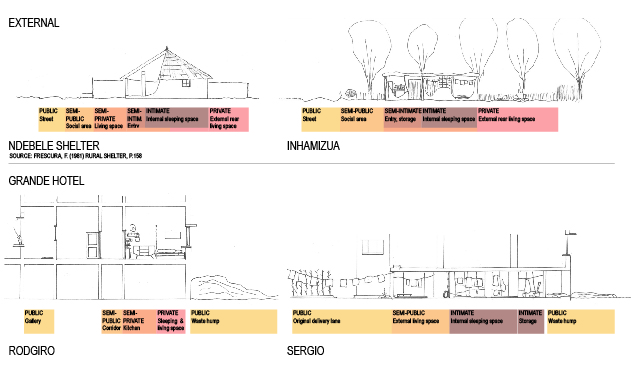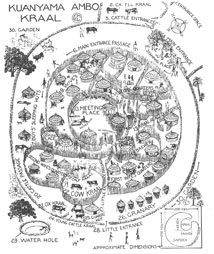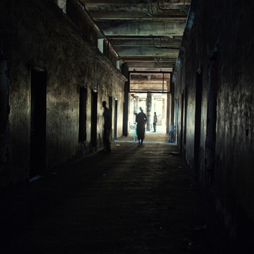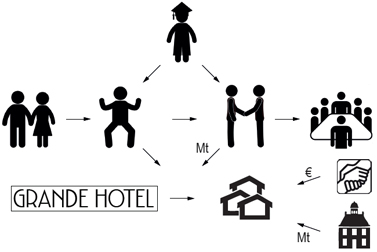The story of the Grande Hotel is a striking story that shows the contrasts and contradictions between different societies and cultures that are established by colonialism in an African country such as Mozambique. The building shows the effects which modern architecture has on a native African society that was originally not intended in the architectural design. The inhabitants of the Grande Hotel where forced to adjust their life style though the architecture that was related to the unfamiliar Western life style and living standards that they never experienced. The aim of the research is to give insight of how the current general living condition of an African society is shaped in a building of western modern architecture, like the Grande Hotel, which is currently occupied. The summary of the research could be considered as a schedule of design recommendations for to improve the current living conditions of the Grande Hotel to a more permanent place of residence.
Jürgen Osterhammel defined the term colonialism by the following words: “a relationship between an indigenous (or forcibly imported) majority and a minority of foreign invaders. The fundamental decisions affecting the lives of the colonised people are made and implemented by the colonial rulers in pursuit of interests that are often defined in a distant metropolis. Rejecting cultural compromises with the colonised population, the colonisers are convinced of their own superiority and their ordained mandate to rule.” This type of colonialism has also happened in Mozambique. Portugal was one of the latest colonial rules that gave their colonies independence in 1975. The influences of the colonial era are still present in the current daily life, although the native population was in the past hardly connected to the colonial governance of the Portuguese fascistic regime. After independence, the native Mozambican population had to deal with the abounded heritage of the colonists. This alien heritage was left when the colonists moved away during the Portuguese exodus. This process started after the independence proclamation of Mozambique.
The colonists built the Grande Hotel as a palace to accommodate influential guest in the ordinary harbour city of Beira. However, when we look to the building today it can be seen as a ‘white elephant’. The Grande Hotel was too big, too expensive, located at the wrong place, created in the wrong time and with the wrong intentions. The building opened in 1955 and in 1963 it was already closed. After the independence of Mozambique, a civil war happened between 1977 and 1992. During the war the Grande Hotel became a military base and transformed slowly into a refugee camp. Today – after 37 years of independence, 20 years of peace and 18 years of freedom and democracy – the Grande Hotel is still facing urgent problems on all kind of levels.
The Grande Hotel could be defined as a slum according the definition of UN Habitat. It defines five criteria that makes a living environment a slum, if it apply to one criteria you may consider it as a slum. The criteria are: (1) that a household as a group of individuals who are living under the same roof, in an urban area, who lack durable housing of a permanent nature that protects against extreme climate conditions, (2) there is structural insufficient living space, which means that more than three people has to share one room, (3) there is no easy access to safe water in a sufficient amount and at an affordable price, (4) there is no adequate sanitation present which serves the community on a sufficient matter and (5) there is no security of tenure that prevents forced evictions. The Grande Hotel applies to all criteria except the first one. The construction of the Grande Hotel is of a permanent nature and does apply shelter against extreme climatic conditions.
Methodology
The main research question of ‘What are the needs and desires of the current inhabitants to adjust the Grande Hotel to a more permanent dwelling place?’ results to a general summary of how the Grande Hotel can be developed to a prosperous living place for its current inhabitants. This main research question is elaborated into seven detailed topics. The general summary is one of the fundaments on where the design is based on the base of the design process
The survey on-site is done during my study trip in March 2012. I visited the Grande Hotel, did the ethnographic research and interviewed several professionals. The graduation class of the Faculdade de Arquitectura e Planeamento Físico of the Universidade Eduardo Mondlane in Maputo, Mozambique helped me indispensably in Beira. It opened essential doors which where fundamental for the success of this project.
The Daily use
The architecture of the Grande Hotel forces the inhabitants to re-arrange their rituals of daily use. In some cases it happens successfully, but not for most rituals. The general distribution of functions in a dwelling is visualised in the sections with privacy gradient (Fig. 1). In comparison with a native and current example is the transition of a dwelling in the Grande Hotel blurred Hotel. Paito is forced to cook in public space by the fixed division of space of his hotel room. The self-made ‘in-built’ shelters in the Grande Hotel have a similar organization to the native example and distinguished them of the original spatial organization of the Grande Hotel. Another example of misuse is that Paito is forced to share his semi-private living space with the intimate sleeping space, while this is normally strong separated in Mozambique. It is interesting how the current culture of daily living adapted the original structure of the Grande Hotel, which is designed for the original proposed luxurious Western holiday lifestyle. Southern African societies have a strong ability to adapt rituals of foreign cultures in their daily lives. This is only possible when the mutation does not compete with their existing rituals. This happened in the situation of the Grande Hotel. The design of adjustment should take a step back in the ‘civilization’ towards Western living standard and respect the value of the existing African standard in general.

Fig. 1: Sections with privacy gradiency of two examples (abolve) and two dwellings in the Grande Hotel (below)
Public health
According to the Red Cross is at the Grande Hotel a high risk for epidemics of cholera, malaria, diarrhoea and scabies. The sources are: the large garbage humps, the highly polluted swimming pool and the absent of sufficient access to fresh water, food and sanitation. Possible solution could be to add relevant infrastructure and spatial actions against the hazardously sources. To tackle the core problem of the public health problems is to release the Grande Hotel inhabitants of the vicious circle of poverty. The Grande Hotel is located on a central spot in the city of Beira. Socially, the inhabitants are located on the edges of the city. The Grande Hotel inhabitants should get a possibility to integrate in the urban society and become able to develop a sufficient living for their own. The tackling of the bad public health situation could be also an opportunity of self-empowerment for the Grande Hotel inhabitants. They could start to digest the large garbage problem by starting their own businesses in the spectrum of recycling and reparation of discard materials.
Social conditions
The spatial distribution of the dwellings along the dark corridors illustrates the social coherence between the households in social, livelihood and nursing matters. Within the Grande Hotel is the community not based on mutual relationships but on the economic interest of daily survival. The spatial and social layout of the linear corridors (Fig. 3) is contrary to the social cohesion of communities in Mozambique. The origin of the social cohesion is well illustrated in the ‘kraal’ concept or in the concept of ‘ubuntu’. As figure 2 illustrates, consists a kraal of different huts. Each hut belongs to an individual that has his own tasks within the community. The task of each individual makes an essential contribution to the survival of the community as a single organism. The communal spaces have the largest and most dominant positions within the kraal. The different clusters of huts are orientated in such a way that the whole kraal is in a controllable social balance. Radical measures should been taken to improve the social cohesion of the Grande Hotel. The communal principle of the kraal concept should be re-introduced on a spatial matter. It needs to take in consideration to balance and respect the past adoption of Western principles into the general society. Today each individual dwelling and livelihood in demands more privacy and responsibility.


Fig. 2: Concept plan of a kraal Fig 3: Ground floor corridor of block B
Political situation
The political situation in Southern Africa is generally based on the rule of one mayor party. The opposition parties has hardly any power by their inequality. The second opposition party governs Beira. It results in a bad political relationship and thwart between the dominant central government and the municipality. The municipality relays on external financial and aid sources to get things done. The Grande Hotel suffers from this political situation. Besides the electoral promise of intervention, the municipality cannot fulfil the promise because of the absent of budget. The promise is to replace the current inhabitants and give a participating foreign investor the possibility to develop the site by its own interest. It shows that votes have not more and decisive power towards money. It is often that vulnerable people are forced to be replaced for the interest of foreign investors. The absent of any progress could lead to that the inhabitants gather together for to improve their own living conditions. It is recommend to restore the ‘Grande Hotel Board’ and to grant right of residence for the current inhabitants. The internalization of a dwelling place changes the mind-set and treatment towards living environment. The mind-set will be transformed from semi-temporal treatment to a permanent care to maintain it proper and liveable. The Grande Hotel will be transformed to a valuable living environment.

Fig. 4: Suggested approach to improve the living conditions of the Grande Hotel by self-empowerment
Socio-economic situation
Poverty is perhaps the greatest cause of the bad conditions of the Grande Hotel. Today are the socioeconomic possibilities under pressure in Beira for to release you from poverty. The sea harbour of Beira attracts foreign companies which start to takeover the popular places of the city in disadvantage for the informal economic activities. Neoliberalism starts to touchdown in Beira. The existing Beirians do not benefit from this process. The formal companies do not offer sufficient jobs for the less- and poor educated majority. The majority remains to relay on the informal economic sector as primary livelihood. The informal economic sector is also for the Grande Hotel inhabitants the only possible sector to develop a sustainable income. Today they are excluded for participating in the informal economic sector; the ‘whate mundo’. To be able to develop the Grande Hotel community without interfering the existing informal economic sector, there should be a new market introduced which complement the existing. The new economic possibilities could generate a more sustaining income and creates social integration. The increasing wealth will also provide future possibilities to invest in the dwellings and common facilities at the Grande Hotel. The desire is that one day the Grande Hotel inhabitants are fully accepted as inhabitants of Beira and that the nickname of ‘whato mundo’ is disappeared.
Architectural value
The Grande Hotel is one of the most iconic buildings of Beira. It has a remarkable history that makes it a symbol of contrasts. Contrasts between ‘the stamp’ of the Western civilisation which is put on Mozambique and how the native society adapted the foreign infrastructure as their living environment. The phenomena of adaption of the build-up living environment is an ancient principal which also infect change to historical tribes when they moved to a new living environment. The contrasts that the native society faces at the Grande Hotel are enormous. Instead that the native inhabitants could rebuilt a building similar to the Grande Hotel for themselves, they had to adapt the existing structure. This forced them to change their lifestyle and faced new problems by the bad integration. It is interesting to see which kind of conflicts appears between modern Western architecture and the semi-rural African lifestyle. Within the architectural adjustment should all these conflicts be addressed. The Grande Hotel should not only be a negative symbol of contrasts by historical influences, it should also show how these contrasts are adapted towards a prosperous future era. The Grande Hotel should be seen as a representative symbol of self-empowerment towards the whole Southern Africa region.